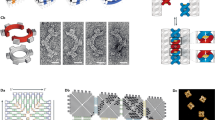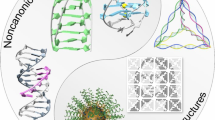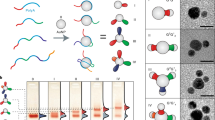Abstract
The ultimate bottom-up approach for the construction of functional nanosystems requires the precise arrangement of atoms and molecules in three dimensions. DNA is currently one of the most prominent molecules able to self-assemble into complex networks1,2 and is therefore regarded as the ‘silicon of the nano-world’3. Metals and metal ions, in contrast, are the atomic building-blocks needed in such materials to establish functions such as electrical conductivity or magnetism. Here we report a new concept, which efficiently combines metal ions and DNA. The DNA structure is used as a matrix to program robustly the complexation of different metal ions under precise control with regard to element, number and composition.
This is a preview of subscription content, access via your institution
Access options
Subscribe to this journal
Receive 12 print issues and online access
$259.00 per year
only $21.58 per issue
Buy this article
- Purchase on Springer Link
- Instant access to full article PDF
Prices may be subject to local taxes which are calculated during checkout




Similar content being viewed by others
References
Gothelf, K. V. & LaBean, T. H. DNA-programmed assembly of nanostructures. Org. Biomol. Chem. 3, 4023–4037 (2005).
Tanaka, K. & Shionoya, M. Bio-inspired programmable self-assembly on DNA templates. Chem. Lett. 35, 694–699 (2006).
Luo, D & Li Y. Nucleic acid engineered nanomaterials and their applications. Handbook of Nanostructured Biomaterials and their Applications in Nanobiotechnology 2, 223–345 (American Scientific Publishers, Stevenson Ranch, 2005).
Marquis, A. et al. Messages in molecules: ligand/cation coding and self-recognition in a constitutionally dynamic system of heterometallic double helicates. Chem. Eur. J. 12, 5632–5641 (2006).
Gait, K. J. (ed.) Oligonucleotide Synthesis: A Practical Approach (IRL Press, New York, 1990).
Tanaka, K. et al. A discrete self-assembled metal array in artificial DNA. Science 299, 1212–1213 (2003).
Tanaka, K. & Shionoya, M. Synthesis of a novel nucleoside for alternative DNA base pairing through metal complexation. J. Org. Chem. 64, 5002–5003 (1999).
Tanaka, K. et al. Efficient incorporation of a copper hydroxypyridone base pair in DNA. J. Am. Chem. Soc. 124, 12494–12498 (2002).
Tanaka, K., Yamada, Y. & Shionoya, M. Formation of silver(I)-mediated DNA duplex and triplex through an alternative base pair of pyridine nucleobases. J. Am. Chem. Soc. 124, 8802–8803 (2002).
Clever, G. H., Polborn, K. & Carell, T. A highly DNA-duplex-stabilizing metal–salen base pair. Angew. Chem., Int. Ed. 44, 7204–7208 (2005).
Clever, G. H. et al. Metal salen-base-pair complexes inside DNA: complexation overrides sequence information. Chem. Eur. J. DOI: 12, 8708–8718 (2006).
Meggers, E. et al. A novel copper-mediated DNA base pair. J. Am. Chem. Soc. 122, 10714–10715 (2000).
Zimmermann, N., Meggers, E. & Schultz, P. G. A novel silver(I)-mediated DNA base pair. J. Am. Chem. Soc. 124, 13684–13685 (2002).
Weizman, H. & Tor, Y. 2,2′-Bipyridine ligandoside: a novel building block for modifying DNA with intra-duplex metal complexes. J. Am. Chem. Soc. 123, 3375–3376 (2001).
Switzer, C., Sinha, S., Kim, P. H. & Heuberger, B. D. A purine-like nickel(II) base pair for DNA. Angew. Chem., Int. Ed. 44, 1529–1532 (2005).
Kuklenyik, Z. & Marzilli, L. G. Mercury(II) site-selective binding to a DNA hairpin. Relationship of sequence-dependent intra- and interstrand cross-linking to the hairpin-duplex conformational transition. Inorg. Chem. 35, 5654–5662 (1996).
Miyake, Y. et al. MercuryII-mediated formation of thymine-HgII-thymine base pairs in DNA duplexes. J. Am. Chem. Soc. 128, 2172–2173 (2006).
Acknowledgements
This work was partially supported by Grant-in-Aids for Young Scientists (A) to K.T., Priority Area to K.T. and M.S., Scientific Research (S) to M.S., and the 21st Century COE Program for Frontiers in Fundamental Chemistry to M.S. from the Ministry of Education, Culture, Sports, Science and Technology (Japan), The Toray Science Foundation to K.T. and the Deutsche Forschungsgemeinschaft (DFG) to T.C., as well as the Volkswagen Foundation. G.H.C. acknowledges the Funds of the German Chemical Industry for a pre-doctoral Fellowship.
Author information
Authors and Affiliations
Contributions
K.T., G.H.C., M.S. and T.C. planned the project and analyzed the experimental data. K.T., Y.T., Y.Y. performed the experiments on the duplexes containing the hydroxypyridone ligands and G.H.C. and K.C. performed the experiments on the duplexes containing the salen ligand.
Corresponding authors
Ethics declarations
Competing interests
The authors declare no competing financial interests.
Supplementary information
Rights and permissions
About this article
Cite this article
Tanaka, K., Clever, G., Takezawa, Y. et al. Programmable self-assembly of metal ions inside artificial DNA duplexes. Nature Nanotech 1, 190–194 (2006). https://doi.org/10.1038/nnano.2006.141
Received:
Revised:
Accepted:
Published:
Issue Date:
DOI: https://doi.org/10.1038/nnano.2006.141
This article is cited by
-
Rational design of metal-responsive functional DNA supramolecules
Journal of Inclusion Phenomena and Macrocyclic Chemistry (2024)
-
Stable Hg(II)-mediated base pairs with a phenanthroline-derived nucleobase surrogate in antiparallel-stranded DNA
JBIC Journal of Biological Inorganic Chemistry (2020)
-
DNA nanotechnology
Nature Reviews Materials (2017)
-
A metallo-DNA nanowire with uninterrupted one-dimensional silver array
Nature Chemistry (2017)



